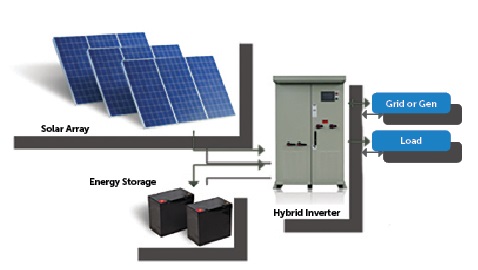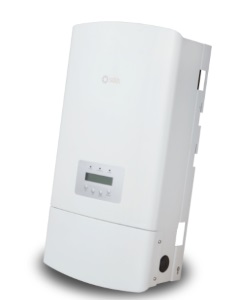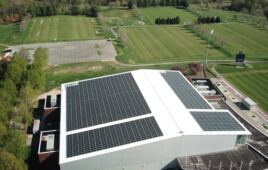See also: Hybrid inverters can future-proof solar+storage installations
Hybrid inverters are commonly used in the developing world, but they are starting to make their way into daily use in certain areas of the U.S due to their ability to stabilize energy availability.
A solar inverter’s main job is to convert DC power generated from the array into usable AC power. Hybrid inverters go a step further and work with batteries to store excess power as well. This type of system solves issues renewable energy variability and unreliable grid structures.

A hybrid inverter system in a residential installation. Hybrid inverters work with batteries to store power. Source: OutBack Power.
“Inverters for grid-tied applications can only provide power based on what the array can immediately generate from the sun,” explained Bryan Whitton, product manager at Darfon. “Hybrid inverters can store power in batteries and then drawn upon it as needed for energy stabilization.”
Hybrid inverters can vary in size, performance and features. But Mara White, product manager for OutBack Power, said most models usually operate bi-directionally, meaning they can convert DC power from modules to usable AC power and then convert stored AC from the batteries to power loads when needed. “Hybrids can also remain grid-connected and use a mix of renewable and non-renewable energy to charge batteries and offset loads,” White added.
Some contractors have used hybrid inverters in the residential, remote home applications for the past decade or two. But Allan Gregg, VP of applications engineering at GreatWall—which manufactures Satcon inverters—said the range of applications has expanded over the past few years to include large capacity microgrids as well as grid-connected systems.
Historically, hybrid inverters have been used more frequently in developing countries that do not have access to a reliable power grid.
“In North America and Europe, hybrid inverter-based systems are usually elective,” White explained. “Users choose to use them for storing energy for self-consumption or provide back-up power during emergencies. But in the developing world, hybrids are more of a necessity to compensate for weak or intermittent grids or a lack of grid electricity all together. Microgrids in places such as India, Asia and Africa are also driving hybrid inverter adaptation.”

An example of power flow in a hybrid inverter system. The inverter can direct power to a load or the grid if needed, or store it in batteries if not. It can also use power from the grid if needed. Source: GreatWall
Still, Whitton said hybrid models are beginning to be used on a more daily basis in areas of the U.S. where the grid is unpredictable, such as Hawaii, or in states where net-metering has been widely supported. “Applications with less than ideal solar characteristic are also good for hybrid-based systems because they can store power and redistribute it during peak times, improving payback,” he added. “Basically, if the site has the potential for losing the grid frequently, you should consider a hybrid for off-grid operation.”
Having the flexibility of a hybrid system can add initial cost to a project, though experts say this can be offset by the ability to self-consume all of one’s available PV electricity.
There are also important design considerations when using hybrid inverters. For example, Gregg warned that the battery bank voltage should be compatible with the DC input requirements of the inverter, and there should be enough solar capacity to supply the load as well as charge the batteries.
Wiring can also be more complex when using hybrid inverters, especially when panels are dedicated for critical backed-up loads. “And as with any device that does several jobs at once, a hybrid inverter is usually slightly less efficient,” White added, “although, improvements in other balance-of-system components can compensate for that slight loss easily.”
There are also specific electrical safety issues with any type of energy storage, so White recommended getting specialized training in energy storage techniques and design. “Most available training is focused on simple grid-tied systems because they have been the majority of U.S. solar installations until now,” she said. “But with incentives changing and the surge in energy storage interest and applications, it’s important to get ahead of the curve and get advanced training quickly.”
Andrew McCalla of Austin, Texas-based Meridian Solar, a Solar Power World top contractor, said he commonly used hybrids in the mid to late ’90s when the now standard grid-tie inverter sector was just a glimmer. “I can imagine that, when regulatory hurdles are fabricated to limit the consumer and societal benefits of bi-directional power flow from distributed generation, these battery-based platforms will become far more common. What is old is new again!”
Another breed of hybrids
 Another segment of hybrid inverters includes inverters that can use two energy sources. For example, Ginlong offers a PV / wind hybrid inverter that has inputs for both sources, instead of having to use two inverters. In much of the United States, wind speeds are low in the summer when the sun shines brightest and longest. The wind is strong in the winter when less sunlight is available. Therefore, because the peak operating times for wind and solar systems occur at different times of the day and year, such hybrid systems have the potential to produce power when it’s needed, and reach a higher return on investment.
Another segment of hybrid inverters includes inverters that can use two energy sources. For example, Ginlong offers a PV / wind hybrid inverter that has inputs for both sources, instead of having to use two inverters. In much of the United States, wind speeds are low in the summer when the sun shines brightest and longest. The wind is strong in the winter when less sunlight is available. Therefore, because the peak operating times for wind and solar systems occur at different times of the day and year, such hybrid systems have the potential to produce power when it’s needed, and reach a higher return on investment.




HI I have an 8.8Kw Sunsynk Inverter with 12 Solar panels connected 9 panels on one MPTT and 3 to the other, and Two 5.5KW Sunsynk Batteries….can this cause an imbalance in the PV’s abilities to create power.
We had the setup a few weeks earlier comprising of 8.8 Kw Inverter , one battery and 9 panels connected to one MPTT and it was producing more KW from the PV setup
Is mppt needed alongside solar hybrid inverter??
No, hybrid inverter has an inbuilt MPPT controller
I live in Nigeria where electricity from the grid is not regular. Can a hybrid inverter system utilising solar power and battery storage be synchronised with power from the grid such that whenever power is available on the grid, the hybrid inverter can take about 10% of power from it and the rest 90% from the solar system + battery storage? Since energy from the sun is inconsistent, you will also expect solar power to fluctuates. Can the hybrid inverter system handle this situation ensuring 100% power availability?
Such configurations all depends on the power of your Pv array, location , orientation and peak sun hours.
Hybrid inverters has an inbuilt programmed source priority that can be selected to meet your design, but deciding how much power that would be drawn from the grid directly depends on the production of your pv array.
Don’t forget that due to the erratic power supply in your country a source priority of SUB( Solar-Utility-Battery) should be adopted.
Your overall Pv array power should be greater than the load by 40 or 50 percent to compensate for losses
Then your battery bank should be at least 50 percent more than your daily kWh consumption
Ac battery charging from grid should be off or set to Solar only to maximize your goal of offsetting your utility bills according to your design and needs
Will hybrid inverter trip in case of overload condition if grid is available.
e.g if inverter is 10KW and load is 15kw will inverter trip or it will do sharing with grid.
Thank you.
It will trip off, since the load is greater than the rated value of the inverter..
Can a properly designed solar hybrid system act as a UPS supply for a medical lab?
Yes, this is possible. A lot of calculations needs to be put in place here: questions like “How long do you want this backup for and so on.
I am happy to enlighten you on this
I have a house that I would like to supply its load using solar system and the utility grid together at the same time, what I am wondering about is, Can I supply let’s say 25% of the load through the solar system and the rest of the load through the utility, knowing that both power sources will be connected through an inverter and then to a distribution board, the point is I want an inverter or an idea that can allow me to combine two different sources to supply the same load at the same time.
you can opt for on grid solar system. Where during day time whatever energy generated consumed by load. if energy generated is more than rest energy supplied to grid through bi directional meter and electrical supplier is pay you for that.
You can do some isolation. Have some circuits powered from the grid,and others from your solar.
You can do load separation. Have some selected loads powered by solar, when you have supply from utility energy source or Gen it automatically powers the entire loads in your house. In this case, only your critical loads are connected to solar as well as to the utility souce
This means that the hybrid inverter works as an inverter and as a converter also tieing the grid the main load current passes through the circuit and how can the circuit stand that current also can we tie a standby diesel genset to the inverter whatever the outgoing voltage? what about maintenance and repair if any?
Thanks
how to connect hybrid inverters? Is the capacity in grid tie the same as the capacity in
off grid using batteries?